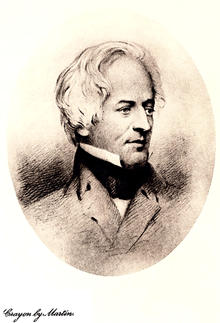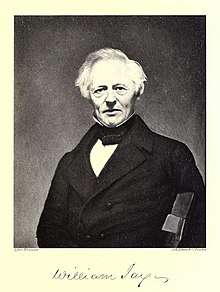William Jay (jurist)
William Jay (16 June 1789 – 14 October 1858) was an American abolitionist and jurist, son of Governor of New York and first U.S. Supreme Court Chief Justice John Jay.
William Jay | |
|---|---|
 | |
| Born | 16 June 1789 |
| Died | 14 October 1858 (aged 69) Bedford, New York, U.S. |
| Alma mater | Yale College |
| Occupation | Judge |
| Home town | Bedford, New York, U.S. |
| Spouse(s) | Augusta McVickar
( m. 1812; died 1857) |
| Children | 8, including John Jay (lawyer) |
| Parent(s) | John Jay Sarah Livingston Jay |
| Relatives | William Livingston (grandfather) |
| Signature | |

Early life
Jay was born in New York City on 16 June 1789, in between his father's terms as United States Secretary of Foreign Affairs in the administration of George Washington. He was the son of John Jay (1745–1829) and Sarah Van Burgh (née Livingston) Jay (1756–1802). Among his older siblings was Peter Augustus (who served as Recorder of New York City under Richard Riker), Susan, Maria, and Ann Jay.[1]
His maternal grandparents were Susannah (née French) Livingston and William Livingston,[2] an attorney who was a signer of the United States Constitution and later served as the first post-colonial Governor of New Jersey during the American Revolutionary War.[3][4] His paternal grandparents were Peter Jay, a wealthy trader in furs, wheat, timber, and other commodities, and Mary (née Van Cortlandt) Jay (daughter of New York mayor Jacobus Van Cortlandt).[5]
He graduated from Yale College in 1808.[6]
Career
After his graduation, he took up the management of his father's large estate in Westchester County, New York, and also studied law at Albany. Poor eyesight soon compelled him to give up the legal profession. He early became interested in various philanthropic enterprises and reforms and identified himself especially with the temperance, antislavery, and antiwar movements. He was one of the founders (in 1816) of the American Bible Society, which he defended against the vigorous attacks of the High Church party, led by Bishop John H. Hobart. He was Judge of Common Pleas in New York from 1818 to 1820, and was first judge of Westchester County from 1820 to 1842, when he was removed on account of his anti-slavery views.[6]
An enthusiastic member of the American Anti-Slavery Society, whose constitution he drafted,[7] Jay stood with James Birney at the head of the conservative abolitionists, and by his calm, logical, and judicial writings exerted for many years a powerful influence. From 1835 to 1837 he was the society's corresponding foreign secretary. In 1840, however, when the society began to advocate measures which he deemed too radical, he withdrew his membership, but with his pen he continued his labor on behalf of the slave, urging emancipation in the District of Columbia and the exclusion of slavery from the territories, though deprecating any attempt to interfere with slavery in the states.[8]
He was also a proponent of antiwar theories and was for many years president of the Peace Society. His pamphlet War and Peace: the Evils of the First with a Plan for Securing the Last, advocating international arbitration, was published by the English Peace Society in 1842, and is said to have contributed to the promulgation, by the powers signing the Treaty of Paris in 1856, of a protocol expressing the wish that nations, before resorting to arms, should have recourse to the good offices of a friendly power.[6]
Personal life
In 1812, Jay was married to Augusta McVickar (1790–1857), the daughter of John McVickar, Esq. of New York.[9] Together, William and Augusta were the parents of eight children, all but two who survived to adulthood. Their children included:[10][1]
- Augusta Jay, who married John Nelson.[1]
- Maria Banyer Jay (1802–1851), who married John F. Butterworth.[1]
- John Jay (1817-1894), who served as U.S. Minister to Austria-Hungary under President Ulysses S. Grant.[11]
- Sarah Louisa Jay (1819–1905), who married Dr. Alexander M. Bruen.[1]
- Eliza Jay, who married Henry Edward Pellew.[1]
- Augusta Jay (1833–1917), who married Henry Edward Pellew after Eliza's death.[1]
Jay died at his residence in Bedford, New York on 14 October 1858.[9]
Assessment
According to Frederick Douglass, Jay "was our wise counsellor, our fine friend, and our liberal benefactor." Lewis Tappan described him as "one of the most talented and useful abolitionists in this country, who, by his pen and active labours, has performed a greater service to the cause than perhaps any other man".[12]
Publications
- Jay, William (1833). The life of John Jay: with selections from his correspondence and miscellaneous papers. 2 vols. Volume 2. New York: J. & J. Harper.
- Jay, William (1835). An Inquiry into the Character and Tendency of the American Colonization and American Anti-Slavery Societies. [Republished 1838 by the American Anti-Slavery Society.]. New York: Leavitt, Lord & Co.CS1 maint: extra punctuation (link)
- Jay, William (1837). A View of the Action of the Federal Government in Behalf of Slavery. Utica, New York: J. C. Jackson, for the New York Anti-Slavery Society.
- Jay, William (1842). War and Peace: the evils of the first and a plan for preserving the last. Reprinted [1919] from the original edition of 1842, with an introductory note by James Brown Scott, Director of the Division of International Law of the Carnegie Endowment for International Peace. New York: Oxford University Press.
- Jay, William (1849). A Review of the Causes and Consequences of the Mexican War. Boston: Benjamin B. Mussey.
- Jay, William (1850). Reply to remarks of Rev. Moses Stuart, lately a professor in the theological seminary at Andover, on Hon. John Jay, and an examination of his Scriptural exegesis, contained in his recent pamphlet entitled, "Conscience and the Constitution". New York. (On slavery.)
- Jay, William (1853). Letters respecting the American Board of Commissioners for Foreign Missions, and the American Tract Society. New York: Lewis J. Bates. (On their positions on slavery.)
- Jay, William (1853). Miscellaneous Writings on Slavery. Boston: John P. Jewitt & Company.
- Jay, William (1855). Redford, George; James, John Angell (eds.). The Autobiography of the Rev. William Jay: With Reminiscences of Some Distinguished Contemporaries, Selections from his Correspondence, and Literary Remains. Volume 2. New York: Robert Carter & Brothers.
References
- Lamb, Mrs. Martha J.; Harrison, Mrs. Burton (1896). HISTORY OF THE CITY OF NEW YORK; ITS ORIGIN RISE, AND PROGRESS, Vol. III. New York: The A. S. Barnes Company. p. 401. Retrieved 16 April 2019.
- Toner, Emily; Turner, Annie. "Republican Court: Sarah Livingston Jay (1756-1802)". www.librarycompany.org. Retrieved 2 January 2018.
- Livingston, Edwin Brockholst (1910). The Livingstons of Livingston Manor: Being the History of that Branch of the Scottish House of Callendar which Settled in the English Province of New York During the Reign of Charles the Second; and Also Including an Account of Robert Livingston of Albany, "The Nephew," a Settler in the Same Province and His Principal Descendants. New York: The Knickerbocker Press. Retrieved 16 November 2017.
- Reynolds, Cuyler (1914). Genealogical and Family History of Southern New York and the Hudson River Valley: A Record of the Achievements of Her People in the Making of a Commonwealth and the Building of a Nation. Lewis Historical Publishing Company. pp. 1335–1336. Retrieved 16 November 2017.
- Stahr, Walter (2006). John Jay: Founding Father. Continuum Publishing Group. pp. 1–5. ISBN 978-0-8264-1879-1.
- "William Jay". www.encyclopedia.com. Encyclopedia.com. Retrieved 16 April 2019.
- Fea, John (2016). "A Bible House Divided". The Bible Cause : A History of the American Bible Society. New York: Oxford University Press. doi:10.1093/acprof:oso/9780190253066.003.0008. ISBN 9780190253066.
- William Jay and the constitutional movement for the abolition of slavery, by Bayard Tuckerman, with a preface by John Jay. New-York: Dodd, Mead & Co., 1894.
- Cleveland, Charles Dexter (1864). A Compendium of American Literature, chronologically arranged, with biographical Sketches of the Authors, and Selections from their works: On the plan of the Authors "Compendium of English Literature" and "English Literature of the XIXth Century". Biddle.
- The Saint Nicholas Society of the City of New York: History, Customs, Record of Events, Constitution, Certain Genealogies, and Other Matters of Interest. V. 1-. Saint Nicholas Society of the City of New York. 1905. p. 86.
- "JOHN JAY'S CAREER CLOSED; END OF ONE OF THE MOST NOTABLE MEN IN AMERICA. Surrounded by His Family, He Passes Away Peacefully after a Long and Painful Illness -- He Was Ran Over in the Street in September, 1890, and the Injuries He Sustained Led to a General Breaking Up -- Was Nearly Seventy-seven Years Old" (PDF). The New York Times. 6 May 1894. Retrieved 16 April 2019.
- Tappan, Lewis (1852). Reply to charges brought against the American and Foreign Anti-Slavery Society, &c., &c., &c. London. p. 14.
Further reading
- "Character and Works of Jay". Quarterly Christian Spectator. Vol. 5 no. 1. March 1833. pp. 1–20.
Attribution
- This article incorporates text from a publication now in the public domain: Gilman, D. C.; Peck, H. T.; Colby, F. M., eds. (1905). . New International Encyclopedia (1st ed.). New York: Dodd, Mead.
- Jay, John (1892). . In Wilson, J. G.; Fiske, J. (eds.). Appletons' Cyclopædia of American Biography. New York: D. Appleton. (Follows article on his father John Jay.)
- Rines, George Edwin, ed. (1920). . Encyclopedia Americana.
